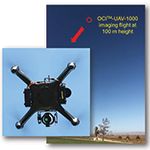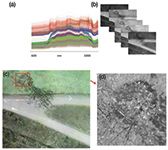Aerial Hyperspectral Imaging by BaySpec OCI Hyperspectral Imagers
Application Notebook
BaySpec's OCI™-UAV hyperspectral imagers are ultracompact, easily deployable, high-performance hyperspectral cameras designed specifically for use on small unmanned aerial vehicles (UAVs), to monitor the details of spatial, temporal, and spectral representation of ground objects. It is available in both push-broom and snapshot versions. Currently, these cameras cover 400–1700 nm wavelength range (custom range available upon request), which is sufficient for varieties of aerial spectroscopic imaging applications such as vegetation characteristics (e.g., precision agriculture). The spectral sensing will provide a multitude of information directly, such as soil constituents, plant type and their state of physiology, level of hydration, just to name a few. Once integrated on low-cost UAVs it rapidly accelerates application areas such as automatic ground surveys, vegetation development stages studies, and so on.
Traditionally, hyperspectral imaging functions involves bulky optics such as prism and constantly moving gratings to disperse wavelength, and complicated imaging detectors and software algorithms to produce the hyperspectral data cube. Although there is great potential and interest in applications for field use, hyperspectral imaging instruments are still largely a laboratory tool. Widespread adoption by various industries has been limited due to the lack of fast, compact, reliable and cost-effective model imagers. To enable the transfer of applications from the lab to industry, BaySpec has overcome the hurdles to miniaturize the instrument in a handheld form. By its proprietary optical integration technology, it removes the need for expensive, bulky and complex optics that are used as scientific instruments today. The result is a fully self-contained, highly reliable unit incorporating a hyperspectral image sensor, on-board computer and battery weighing less than one pound in a volume not much larger than a modern cellular phone.
To accommodate for UAVs flight conditions, all components in the OCI systems are shock-resistant and shielded from electromagnetic interference so they do not interfere with UAV's GPS/autopilot system. Currently, BaySpec packages a multi-motor UAV platform consisting of GPS/IMU autopilot and an active vibration-isolation gimbal system for its hyperspectral imagers (Figure 1).

BaySpec has in-depth experience in developing highly reliable and compact optical spectrometers and cameras. For example, its SuperGamut™ series spectrometer has a very wide spectral range with a compact footprint. These miniaturized spectroscopic systems such as hyperspectral cameras and spectrometers covering short-wavelength infrared (SWIR) range are also available.

The real power of hyperspectral imaging is that the continuous and wide-range spectra from each pixel can be used to characterize the materials quantitatively with high accuracy. The abundance of spectral information enables maximum analytical power and automatic chemometrics algorithms to segment the images according to their material characteristics. The wavelength range of current OCI™-UAV-1000 provides the capability of measuring from visible range to near infrared (VNIR) while maintaining high spatial resolution. Many objects leave unique 'fingerprints' across the VNIR spectrum range that is beyond the capabilities of commonplace image sensors. These spectral signatures enable identification of the materials for quantitative applications, such as forensic analysis, precision agriculture, food processing, biomedical, mineralogy, surveillance, astronomy and environment analysis, to name a few.

BaySpec, Inc.
1101 McKay Drive, San Jose, CA 95131
tel. (408) 512-5928, fax (408) 512-5929
Website: www.bayspec.com
